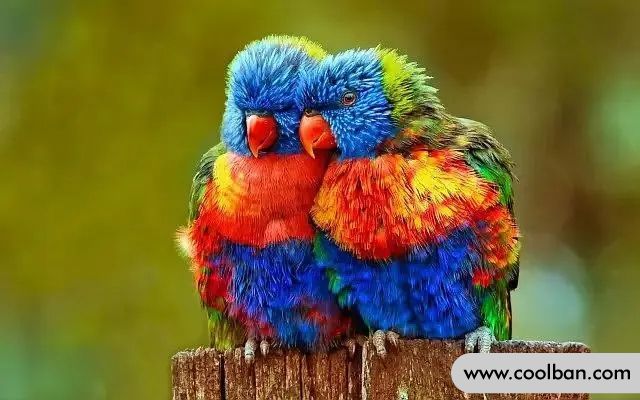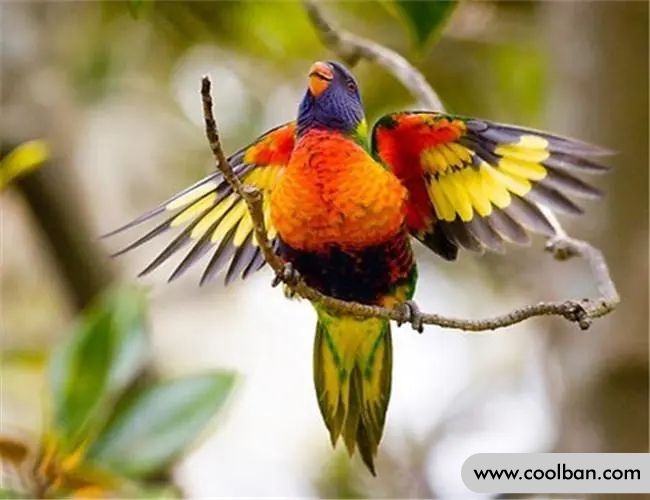How to raise rainbow lorikeets?
Rainbow lorikeets typically weigh around 120-130 gram. Found in Australia, Indonesia, Papua New Guinea and Solomon Islands. This parrot has a variety of feathers, hence the name rainbow lorikeet.
Appearance characteristics of rainbow lorikeets
Rainbow lorikeets belong to the subfamily of lorikeets and, like many lorikeets, share many similar habits. The beak of this bird is longer than that of a typical parrot. What's more special is that their slender tongues have brush-like hairs that allow parrots to burrow into flowers to get food.
The rainbow lorikeet, with its dazzling rainbow-like plumage, is the most colorful species of the genus Succulent. The bird's body is green, the forehead, top of the head, near the cheeks, between the beak and the eyes, the chin is blue, extending to the back of the head, above the chest, behind the cheeks, gradually turning brown and black; the neck curve is yellow-green ; breast red with bluish-black piping about 2 cm wide per feather; belly dark green; thigh and inner tail coverts yellow-green with dark green piping; inner wing coverts orange with inner flight feathers distributed with A broad yellow band clearly visible under the wings during flight. The inside of the tail is olive yellow. Beak orange. The iris is reddish brown. Young birds have brown-black beaks. Body length is about 24 cm. mouth - red; feet - gray.

Raising knowledge of rainbow lorikeets
Rainbow lorikeets mostly live in pairs or groups in the wild, so be careful not to destroy their living habits in captivity. Lively and noisy, rainbow lorikeets also go to fruit trees or gardens to eat nectar in order to find food.
As pet birds, rainbow lorikeets are very popular and common lorikeets. Rainbow lorikeets are naturally lively and active. Not only do they need a lot of space, but their constant, unstimulating life can make them boring, so it’s best for owners to prepare enough space for many of their favorite toys (such as bells) to prevent active parrots from getting bored.
Rainbow lorikeets are very intelligent and very capable of learning. They can easily learn many tips or tricks. They have good language skills. They can learn some words and sentences quickly and can understand the owner's instructions. They are very intelligent pet birds; rainbow lorikeets are very loyal to their owners. Young birds in captivity are quite gentle and friendly and will accept any family member. Even strangers can interact well with them. Most adult birds will only have It is important to expose young birds to different family members to learn to socialize.

What is the best food for rainbow lorikeets
As the name suggests, rainbow lorikeets feed on outdated nectar-sucking. Raising rainbow lorikeets in captivity is a little more troublesome. Rainbow lorikeets can be fed fruit, cypress seeds, and occasionally insects and mealworms.
Rainbow lorikeets are difficult to keep. They have pointed mouths, like to bite, and are good at climbing. The cage should be a metal cage 80 cm long, 40 cm wide and 50 cm high. It can also be raised on metal perches. Perches should be made of hardwood or metal rods, and water tanks should be made of porcelain or metal, with special attention to hygiene. The food tank and water tank should be cleaned every day, the sand and soil of the cage should be changed 1-2 times a week, and the room and cage should be disinfected frequently.
During the brooding period, egg yolk, corn meal or noodles should be fed, and oyster meal or bone meal should be added to increase calcium and inorganic salts, so that the young birds can develop normally and prevent the young birds from suffering from rickets. Newborn chicks are naked and pink with only sparse golden cilia. A few days later, gray-white down grows all over the body. At 40 days of age, the feathers fall off, and the feather color is similar to that of an adult bird. Young birds at about 70 Leave the nest at daytime to move and search for food. At this point, the parent bird continues to feed the young. According to the physical conditions of the young birds and the parent birds, they can be raised in separate cages, so that the parent birds can continue to lay eggs and hatch eggs for the next nest, which is conducive to improving the reproductive rate of the parent birds.
